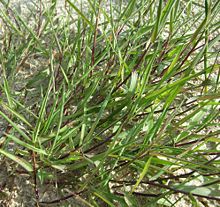- Agrostis stolonifera
-
Creeping Bentgrass 
Habitus Scientific classification Kingdom: Plantae Division: Magnoliophyta Class: Liliopsida Order: Cyperales Family: Poaceae Genus: Agrostis Species: A. stolonifera Binomial name Agrostis stolonifera
L.Synonyms[1] - Agrostis alba L. var. palustris (Huds.) Pers.
- Agrostis alba L. var. stolonifera (L.) Sm.
- Agrostis maritima Lam.
- Agrostis palustris Huds.
- Agrostis stolonifera L. var. compacta Hartm.
- Agrostis stolonifera L. var. palustris (Huds.) Farw.
Agrostis stolonifera (Creeping bentgrass, Creeping bent, Fiorin, Spreading bent, Carpet bentgrass, Redtop[1][2][3]) is a perennial grass species in the Poaceae family. It is stoloniferous and may form mats or tufts. The prostrate stems of this species grow to 1.3-3.3 ft (0.4–1 m) long with 0.8-4in (2–10 cm) long leaf blades and a panicle reaching up to 16in (40 cm) in height.
Contents
Physical description
The ligule is pointed and up to 5mm long. This differs from Common Bent, Agrostis capillaris which is short and does not come to a point.
The leaves are tapering, often with a blue grey hue colour. The grass is not tufted and the spikelets are red and tightly closed within the panicle[4]
It flowers in July and August.
Distribution
It can be found growing in a variety of habitats including woodlands, grasslands and meadows, wetlands, riparian zones, and as a pioneer species on disturbed sites.[3] It is native to Eurasia and North Africa (Algeria, Morocco, and Tunisia). It is possible that it may also be to native to northern parts of North America, and in any case it has been widely introduced and naturalized on that continent and in many other places.[2]
It is a constituent of wet habitats such as marshy grasslands. Some of its species have adapted to contaminated conditions and can cope with heavy metals. It can exist up to 2500 ft.[5]
Cultivation
It is the most commonly used species of Agrostis. [6]
The ability of creeping bentgrass to remain palatable and green in the summer is valued for livestock forage; it also provides good cover for upland game birds and waterfowl. It is used for turf in gardens and landscapes, particularly on golf courses.[3]
References
- ^ a b PLANTS Profile for Agrostis stolonifera Retrieved 2010-03-16.
- ^ a b Germplasm Resource Information Network Retrieved 2010-03-16.
- ^ a b c USDA Forest Service Fire Effects Information System Retrieved 2010-03-16.
- ^ BSBI Description retrieved 2010-11-16.
- ^ Grasses by C E Hubbard, 1978, published by Penguin books
- ^ Watson L, Dallwitz MJ. (2008). "The grass genera of the world: descriptions, illustrations, identification, and information retrieval; including synonyms, morphology, anatomy, physiology, phytochemistry, cytology, classification, pathogens, world and local distribution, and references". The Grass Genera of the World. http://delta-intkey.com/grass/www/agrostis.htm. Retrieved 2009-08-19.
This Pooideae article is a stub. You can help Wikipedia by expanding it. - Agrostis alba L. var. palustris (Huds.) Pers.
